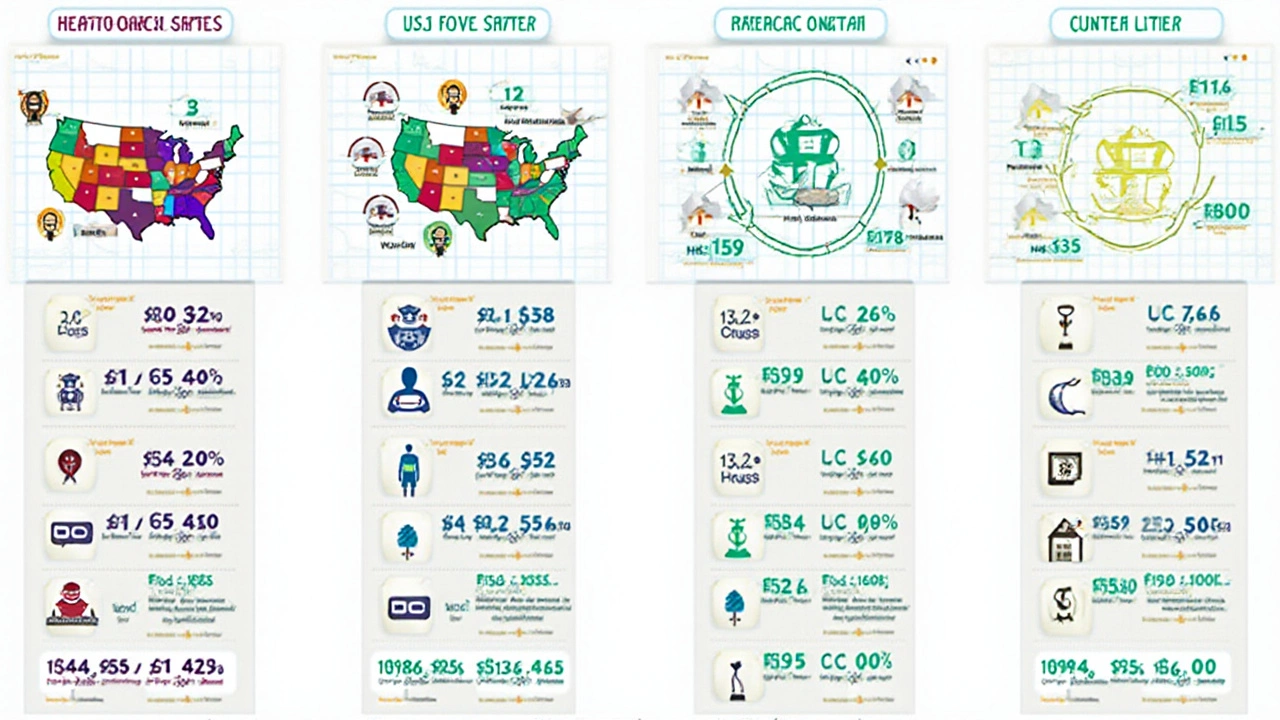In a world where expenses seem to climb ever higher, finding places that offer both financial ease and excellent healthcare is crucial. More people are flocking to states in the US not only for affordable living but also for top-notch medical services. This trend, known as medical tourism, draws those seeking financial relief combined with healthcare advantages.
Choosing the best state to settle in is more than just checking housing or food costs—it's about considering healthcare access and quality. The idea is to live where money stretches further without compromising health standards. This journey through various states will reveal where you can find this balance, enriching not only your health but also your wallet.
- Understanding Medical Tourism and Its Financial Impact
- Key Traits of Financially Accessible States
- Top US States Blending Affordable Living and Healthcare
- Tips for Living Affordably in Medical Tourism Hotspots
Understanding Medical Tourism and Its Financial Impact
Medical tourism, a term that increasingly frequents discussions around health and finance, describes the practice of traveling across countries or states to access healthcare services that are either more affordable or of higher quality than what's available locally. This phenomenon isn't just about getting surgery or treatment at a lower cost; it's a strategic movement combining health and economic savvy. Surprisingly, the United States, a country known for its high medical expenses, still emerges as a hotspot for medical tourism, offering cost-effective solutions and advanced care in various states.
Delving deeper, one can find that certain states in the US offer a unique mixture of affordable living with premium health services. For many, the decision to relocate isn't merely influenced by finances; it’s also about achieving the delicate balance of affordability and quality healthcare. Strong factors such as insurance policies, state-provided healthcare subsidies, and cost of services play significant roles. A report from the Health Institute cited that the medical tourism industry reached $50 billion globally by 2024, acknowledging the increase in intra-national travel for health services.
"Medical tourism is reshaping how people view their health plans and expenditure," remarked Dr. Laura Simmons of the Healthcare Financial Analysts Association. "Patients now possess more power and choice, leading to an informed decision-making process that wasn't as prevalent a decade ago."
The financial impact of medical tourism isn't just limited to individual savings. States offering top-notch medical services often witness economic boosts from the influx of patients who indirectly contribute to local economies. By staying in these states longer for recovery or additional treatments, patients spend on amenities, housing, local attractions, and more. States such as Texas and Florida, known for their advancements in queue-busting healthcare delivery, have reported positive economic upticks linked to medical tourism.
Affordable living is part of the equation too. While typically associated with lower housing or rental costs, the concept here expands to include living a lifestyle where your health and pocket are both nurtured. For example, a state like Florida combines reasonable housing costs with a plethora of medical facilities specializing in geriatrics, cardiac care, and orthopedics, making it a dual attraction for retirees seeking quality and affordability.
The interplay between medical tourism and affordable living reshapes traditional migration patterns. No longer are people moving solely for job prospects or better climates; now they consider healthcare service quality and living costs with equal weight. As this trend grows, states are investing in their medical infrastructure, ensuring they don't just attract patients but also retain them as residents.

Key Traits of Financially Accessible States
When pondering where to reside, it's crucial to understand the characteristics that make a state financially accessible. These traits are not only about the cost but also about various factors that influence day-to-day living and long-term financial stability. One of the prime considerations is the overall cost of living, which encompasses housing, utilities, groceries, and transportation expenses. States with lower costs in these areas tend to provide a more financially secure life, leaving room for savings or other investments. It's worth noting that these states offer affordable options for both renting and homeownership, which is a significant draw for many.
Another vital trait is the availability and quality of healthcare services. A state that pairs affordability with top-notch medical care attracts not only residents but those participating in medical tourism. Quality healthcare should be accessible without exorbitant premiums or out-of-pocket costs. Some states have received accolades for their healthcare systems, ensuring residents do not compromise on health while saving money. A report by the Commonwealth Fund cites states like Hawaii and Massachusetts as leaders in healthcare performance and access, although they might not always be the cheapest places to live.
Taxes form another critical component in evaluating a state's financial accessibility. States with no income tax or those with a more lenient tax code are often viewed more favorably. For instance, states like Texas and Florida offer appealing tax advantages, which can significantly impact annual savings. Residents in these states can typically retain more of their income, thereby enhancing their ability to spend or save as they wish. In these cases, the lack of state income tax often compensates for other financial burdens.
Employment opportunities and economic stability also heavily influence a state's accessibility. States boasting diverse job markets with strong growth prospects tend to support more robust financial health for their residents. Places like Colorado and Utah have been recognized for their thriving industries and low unemployment rates. An improving job market means higher chances of finding stable employment, which directly affects one's ability to live comfortably.
Lastly, consider the educational landscape and its influence on long-term living costs. States prioritizing education tend to have higher school ratings, which can translate into added value for families and future generations. These factors, while indirectly related to financial accessibility, often weigh heavily in decision-making processes for people planning for their children's futures.

Top US States Blending Affordable Living and Healthcare
When considering the best states for affordable living coupled with quality healthcare, several names come to mind. These states offer a unique mix of low living costs and robust medical services, making them prime spots for those interested in medical tourism. Texas, for example, not only boasts no state income tax but also has a thriving healthcare sector. From world-class hospitals to numerous healthcare professionals, the Lone Star State appreciates its residents with efficient medical infrastructure. Not to mention, the reasonable housing prices contribute significantly to the state's appeal.
Then there's Florida, a state known for its warm climate and retiree-friendly lifestyle, also offers affordable healthcare solutions. With cities like Miami and Tampa leading the way, Florida provides excellent healthcare services alongside a relatively low cost of living. Many facilities offer specialized treatments that are praised internationally, ensuring that residents or visitors can expect top-tier medical attention. Adding to the enticement is the state's widespread acceptance of various health insurance plans, easing the financial burden even further.
Surprisingly, Tennessee emerges as a powerful contender in this arena. Known for having no income tax and a low cost of living, Tennessee also presents affordable healthcare options with a quality that rivals other states. Nashville, often referred to as the healthcare capital, is home to some of the biggest names in the medical industry. The state's commitment to health education and extensive healthcare networks provide a solid foundation for both residents and visitors looking for quality care at affordable rates. A local healthcare professional notes,
"Tennessee's healthcare system is built on a balance of accessibility, affordability, and innovation."
Moreover, Iowa stands out with its highly efficient healthcare system and reasonable living costs. Known for its friendly communities and a strong sense of safety, the state provides both residents and visitors an opportunity to experience a relaxed yet health-conscious lifestyle. Cities like Des Moines host sophisticated medical facilities that draw patients from various regions due to cost-effective and high-quality health solutions. The synergy between affordable living and stellar healthcare makes Iowa a noteworthy contender on the list.
Each of these states showcases their unique balance of economic practicality and medical excellence. Whether it's the appealing tax-free benefits of Texas or the retiree paradise that is Florida, individuals have multiple options when considering relocation or even temporary stays for medical purposes. The decision boils down to personal preferences and specific healthcare needs, yet the constant is clear—affordable living and healthcare coexist beautifully, making these states a wise choice for the medical tourist.

Tips for Living Affordably in Medical Tourism Hotspots
Many folks are scouring for places that offer both savings on living costs and outstanding healthcare. In these medical tourism hotspots, life can be savvier if you're armed with the right strategies. Imagine planting roots in a state like Florida, Texas, or even Arizona, where the concept of affordable living meets excellent medical care. While everyday costs can vary significantly from one place to another, it's the little tweaks and expert secrets that ensure you get the best bang for your buck. Transportation savings, tapping into local discount programs, and optimizing healthcare insurance are just a few tips to make your life easier.
Another terrific way to maintain a budget-friendly lifestyle is to explore the bustling local farmers' markets. These markets not only keep you in touch with fresh produce, often at reduced prices than big supermarkets, but they help you blend into community life. Alongside, plenty of states also encourage their residents to use public transit, giving them subsidized options. By understanding these opportunities, you can reduce travel expenses, which in turn adds another layer of financial comfort. Let’s not forget the wide array of online platforms now available to connect with others for shared living arrangements, contributing to a substantial reduction in rent and utility expenditures.
"By making the smart choice of where you live, you’re not only saving money but investing in a healthy future. Thoughts echoed by Dr. John Conley, renowned for his study on affordable living and health outcomes."
Considering healthcare is crucial. Many states that are sirens for medical tourism have remarkable healthcare options. It's wise to explore what medical insurance plans align best with these resources. You can also capitalize on state-specific health programs designed to aid residents in gaining quality care without breaking the bank. Understanding these points can vastly cut your healthcare costs. Moreover, establishing a connection with local healthcare networks might present possibilities for discounts or even healthcare plans tailored uniquely for residents or medical tourists.
Keeping Affordability in Mind
Once you're settled, keep a keen eye on monthly expenses. It’s valuable to be proactive—using budgeting apps that offer real-time tracking and alerts. Little things like cooking more at home, cutting down unnecessary subscriptions, and even making do-it-yourself home repairs can translate to considerable monthly savings. Yet, remember trade-offs might be necessary; for instance, an older but well-built house can be much less costly than a new one right in the city’s heart. Access to a good library in your district can be a saving grace, providing you with free books, films, and even workshops that foster community ties and entertainment without the extra cost.
| State | Monthly Living Cost (Approx.) | Healthcare Rating (Out of 10) |
|---|---|---|
| Florida | $2,500 | 8.5 |
| Texas | $2,300 | 8.2 |
| Arizona | $2,400 | 8.0 |
In exploring these avenues, remember that living in these places shouldn't just be about financial viability, but about quality of life. States tailored for medical tourism not only promise cost savings but allow you to enjoy life enriched by cultural diversity, healthy lifestyles, and community connections. These benefits, coupled with strategic financial planning, transform a place into a sanctuary where health, savings, and happiness coexist.
